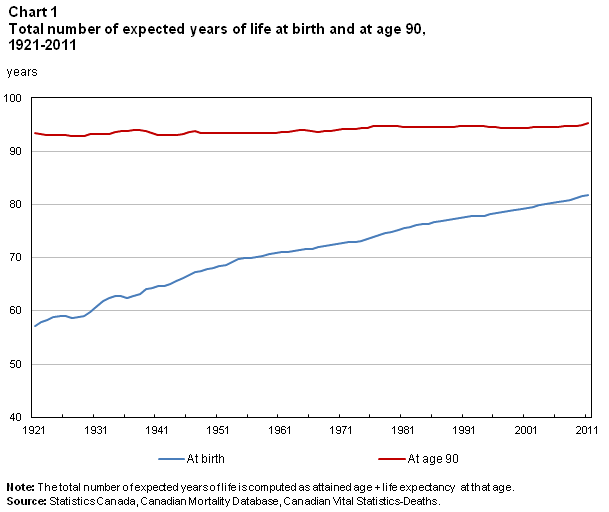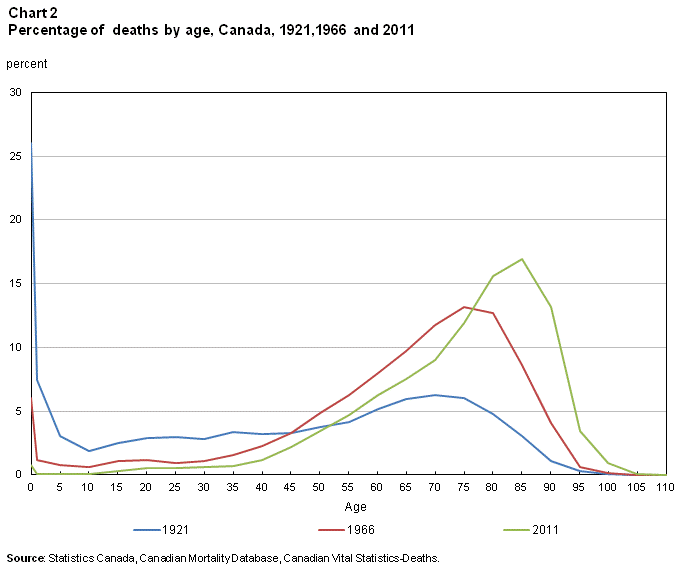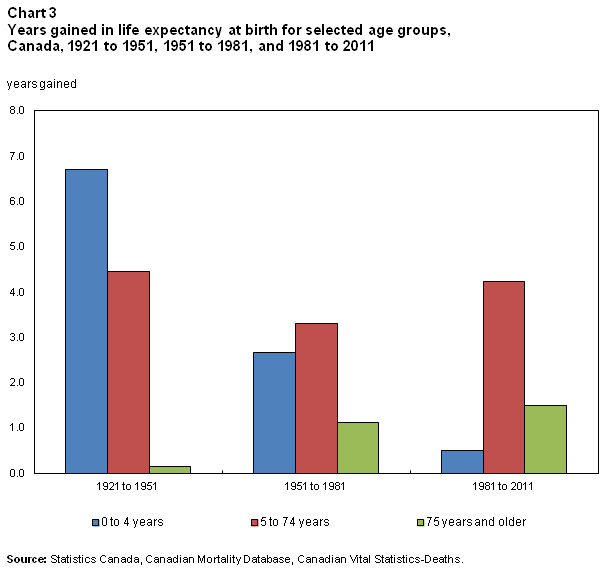How Has The Average Life Expectancy Changed In The Past 100 Years?
Health at a Glance
 View the most recent version.
View the most recent version.
Archived Content
Information identified as archived is provided for reference, inquiry or recordkeeping purposes. It is not subject field to the Authorities of Canada Web Standards and has not been altered or updated since it was archived. Delight "contact u.s." to request a format other than those bachelor.

Ninety years of change in life expectancy
Statistics Canada Catalogue no. 82-624-10
by Yves Decady and Lawson Greenberg
[Full article in PDF]
- Highlights
- Patterns in bloodshed past age
- Changes in life expectancy by historic period
- Changes in life expectancy by causes of decease
- Living longer and quality of life
- Related fabric for this commodity
Commencement of text box
Highlights
- In 2011, Canadians lived an average of 81.7 years. This is an increment of 24.6 years since 1921.
- Most half of all the gains in life expectancy occurred in the period between 1921 and 1951, largely due to reduced infant mortality.
- Reduced deaths from circulatory diseases account for most increases in life expectancy since 1951.
End of text box
It is common to read articles reporting that people in developed countries are living longer, and that more Canadians are reaching 90 or even 100 years of age. Notation 1 In fact, centenarians were the 2d fastest growing age group according to the 2011 Census results. Note 2
Life expectancy is an estimate of the average number of remaining years of life at birth or other ages, based on death rates calculated for a given flow. Because it is an average, some people will live longer and some will not reach the estimated life expectancy. Too, a person can live longer than their life expectancy if they benefit from time to come developments that extend life.
Historically, life expectancy has been lower for men than women. Although the gap between the sexes was pocket-size in 1921 (ane.8 years), it reached a high of 7.4 years in 1975-1977 and narrowed to 4.iii years in 2010-2012. Annotation three Also, during part of this period—from 1920-1922 to 1980-1982, life expectancy at historic period ane has been higher than life expectancy at nativity, mostly as a upshot of high baby mortality. Note 4
In 2011, Note 5 life expectancy at nascence in Canada was 81.7 years. From 1921 to 2011, life expectancy at nativity increased from 57.1 to 81.7, a gain of 24.half dozen years.
While a gain of 24.6 years overall may seem dramatic, life expectancy shows smaller gains over the same fourth dimension period when calculated for older age groups. For example, in 1921, life expectancy at age 55 was twenty years. In other words, the average 55-year-old could expect to live to historic period 75. Today, a 55-twelvemonth-old can await to live an additional 29 years (to age 84), a proceeds of 9 years over the past 90 years.
A similar upshot can exist seen for xc-year-olds. In 1921, life expectancy at age ninety was iii.iv years. By 2011, a xc-year-old could wait to live another five.3 years, a gain of 1.ix years during the 90 year reference period (Chart one).

Description for Chart 1
The to a higher place assay raises a frequently asked question: if life expectancy at birth in 1921 was 57.one years, how is it that in the same year a 55-year-old could look to live another 20 years, or a 90-year-sometime another 3.4 years?
There are at least two reasons for this result. Kickoff, life expectancy is calculated as an average that takes into account deaths at all ages in the population. This reflects the fact that some people live longer and some do not attain the estimated life expectancy. Second, calculating life expectancy at a given age requires survival to that historic period as earlier risks of decease are overcome.
This commodity explores the patterns and frequency of expiry by age and past cause in the population. The main goal is to explicate how and why life expectancy has changed over a 90-yr period. Annotation half dozen Although the article is primarily focused on mortality, it concludes with a brief word almost how living longer may be associated with deteriorating health in later years of life. The main sources of data are the Canadian Vital Statistics Decease Database and the Canadian Mortality Database.
Kickoff of text box
The Canadian Vital Statistics - Death Database (CVS: D) collects demographic and crusade of death data annually from all provincial and territorial vital statistics registries on all deaths in Canada. Causes of death information in this database get back to 1926. In social club to assist with usage, data accept been standardized as of 1974. Note seven
The Canadian Mortality Database (CMDB) is based on the Canadian Vital Statistics Decease Database (CVS: D). The CMDB may contain death records and data updates made after the official publication of the vital statistics. Causes of death data in this database get back to 1950. Note 8
End of text box
Patterns in mortality by age
Ane way to better understand changes in life expectancy over time is to explore the design of the age at death in the population. Nautical chart 2 depicts this by comparing the percentage of deaths by age, for iii different fourth dimension points: 1921, 2011 and the mid-point, 1966.

Description for Chart ii
By examining Chart 2, several important observations tin can be made. Starting time, in 1921 the highest proportion of deaths occurred during the start year of life. This contrasts sharply with the much lower proportion of infant deaths in 1966 and in 2011.
Second, in 1921 nigh deaths occurred over a broad range of years (55 to 79) compared to deaths in 2011 that were more than concentrated in a narrower range of ages (75 to 89). This was due to an increase in deaths among older age groups, and fewer deaths among younger age groups. Also, the most common age at expiry in 1921 (excluding infant deaths) was 70, and by 2011 information technology was 85, an increase of 15 years. Lastly, the peaks of the distributions in Chart 2 become steeper and steeper over time, suggesting that survival to older ages may be approaching a natural limit. Annotation ix
Changes in life expectancy by historic period
Dividing the past ninety years into 30-yr periods shows that the gains in life expectancy for the entire population are slowing down (Chart 3). The largest gain in life expectancy at birth (11.3 years) was betwixt 1921 and 1951. This compares with a gain of seven.ane years between 1951 and 1981, and of half dozen.2 years betwixt 1981 and 2011.
Most of the increases in life expectancy in the past 90 years came from declines in what is oft called premature death, that is to say expiry amidst individuals who are younger than age 75.

Description for Chart 3
Looking at gains past age group within each period (Chart iii) shows that declines in infant and child deaths betwixt 1921 and 1951 contributed the nigh to the increase in life expectancy at birth. Notation 10 That is, during the 1921 to 1951 time menstruation, out of the eleven.3 years gained, vi.7 were the result of improvements in infant (under 1 year of age) and kid (ages 1 to 4) mortality rates. From 1951 to 1981, further declines in infant and child mortality deemed for to 2.7 years out of the 7.one years gain. During the last period (1981 to 2011), this contribution was 0.five years (half dozen months) out of the 6.2 boosted years.
The second largest contribution to increased life expectancy was the reduction in deaths in the 5 to 74 age grouping (Chart 3). Between 1921 and 1951, declines in deaths occurring in the 5 to 74 age range contributed to the remaining gains in life expectancy, that is, 4.v out of 11.three years. From 1951 to 1981, declines in deaths among the five to 74 age group contributed to almost half of the gain in life expectancy, and in the final catamenia (1981 to 2011) to the bulk (two-thirds) of the gain (iv.two years out of half dozen.2).
From 1921 to 1950, several major advances in public health took place. Two noteworthy examples are childhood immunization against infectious diseases, and life-altering scientific discoveries such every bit penicillin and insulin. Note 11 Other major developments with significant impacts on the population health for the remainder of the century and up to the present time included new approaches in health promotion, illness prevention, customs advocacy and the utilize of legislation along with the introduction of broad social programs. Note 12
Over the past 90 years, life expectancy has non greatly increased for those over 75 years of age.
Changes in life expectancy by causes of death
Exploring changes in the master causes of expiry over the past 60 years helps further explain the changes in life expectancy. Notation 13 Reductions in deaths from circulatory arrangement diseases, such as heart disease, were the biggest contributors to gains in life expectancy (Nautical chart 4).
From 1951 to 1981, declines in deaths from infectious and parasitic diseases, and respiratory system diseases were the next biggest contributors to years gained in life expectancy, while cancer survival did not play a role in improvements in life expectancy. However, from 1981 to 2011, longer cancer survival contributed to a gain of 0.8 years (about 10 months) to the life expectancy of the population.

Description for Chart 4
Gains in life expectancy also occurred because there was a reduction in deaths acquired past accidents and violence from 1981 to 2011, contributing a gain of 0.viii years (compared to 0.2 years in the previous 1951 to 1981 catamenia). The reduction in accidents was fostered by various health sensation campaigns and legislation to forestall injury such as making seat belt use mandatory, which contributed to decreased traffic deaths. Annotation xiv
A slight increase in deaths due to infectious and parasitic diseases betwixt 1981 and 2011 contributed to a subtract of 0.one years (nigh a calendar month) in life expectancy. Infectious diseases remain a challenge with the resurgence of previously controlled diseases and the introduction of new infections. Annotation 15
Living longer and quality of life
Although Canadians are living longer, with a life expectancy of 81.7 years and a near common age at death of 85 years, the power of many adults to perform key health functions, that is, their functional health Note 16 declines equally they age. The increasing proportion of Canadians reaching older ages raises issues about demand for health services and commitment of care.
Chart 5 shows that after age 65, the reject in the functional health line tends to accelerate, with more severe disability (many activity limitations) occurring, on average, around age 77.

Description for Chart 5
Commencement of text box
A person's functional health is measured using a scoring arrangement based on self-reported performance on 8 key health attributes: vision, hearing, speech, mobility, dexterity, feelings, noesis and pain. This scoring arrangement, the Health Utility Alphabetize Mark iii (HUI3), was developed at McMaster University. Note 17 This score can be used to categorize people as having varying degrees of disability on a calibration from 0 to 1, where lower numbers mean greater disability. The article focuses on moderate or severe disability:
Moderate inability occurs when a person is prevented from performing some activities due to limitations in their ability to function in at least one of these eight wellness attributes (vision, hearing, speech, mobility, dexterity, feelings, knowledge and pain), and the limitation cannot be corrected (a functional wellness score betwixt 0.7 to 0.nine).
Severe disability occurs when a person is prevented from performing many activities due to limitations in their power to function in at to the lowest degree 1 of these viii health attributes (vision, hearing, speech, mobility, dexterity, feelings, cognition and pain), and the limitation cannot be corrected (a functional health score of less than 0.7).
End of text box
Some other style to wait at the quality of life during the later years of life is to calculate the equivalent number of years a person can be expected to live in good (or "total�) health. Annotation 18 This measure has been qualified as health-adjusted life expectancy (HALE). The latest estimate of health-adjusted life expectancy at nativity is 69 years for men and 71 for women. Note 19 That means that the average Canadian tin can expect to alive roughly 10.v years with some level of disability.
In this context, the challenge for an aging population will be to seek ways to prolong the healthy life years.
Yves Decady and Lawson Greenberg are analysts with the Health Statistics Division.
The authors wish to acknowledge Brenda Wannell, Laurent Martel, Teresa Janz and Bob Kingsley for their contributions.
Notes
- Run across Wister 2007.
- Run across Statistics Canada 2012.
- See Nault 1997.
- Run across Greenberg 2011.
- The life expectancy approximate for the 2010-2012 flow used the Vital Statistics - Death Database for 2010 and 2011 and population and deaths estimates for 2012.
- Encounter Arriaga 1984.
- Meet Statistics Canada. Vital Statistics - Death Database 2013.
- See Statistics Canada. Vital Statistics - Decease Database 2013.
- Encounter Kannisto 2001.
- Encounter Arriaga 1984.
- See Public Health Agency of Canada 2008.
- See Public Health Agency of Canada 2008.
- See Preston 2001.
- See Public Health Agency of Canada 2008.
- See Public Health Agency of Canada 2008.
- The functional health scores in Chart v were calculated by combining the average Wellness Utility Indexes (HUI) from the Canadian Community Health Survey, and the boilerplate HUI from the National Population Health Survey (NPHS) institutional component, according to the proportion of the population.
- See Feng 2009.
- See Wolfson 1996.
- See CANSIM tabular array 102-0122.
Related material for this article
Source: https://www150.statcan.gc.ca/n1/pub/82-624-x/2014001/article/14009-eng.htm
Posted by: northingtondarke1993.blogspot.com


0 Response to "How Has The Average Life Expectancy Changed In The Past 100 Years?"
Post a Comment